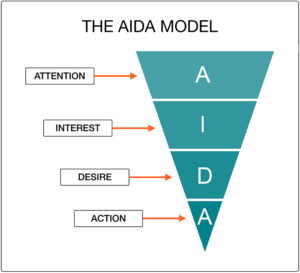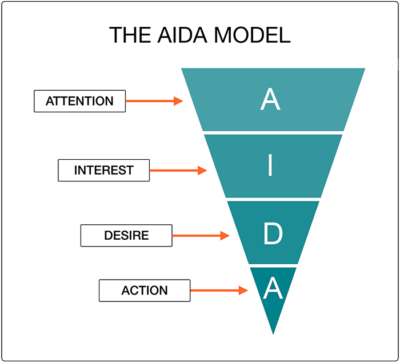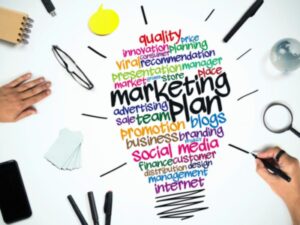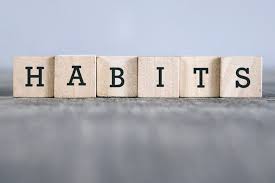If you work in sales or marketing you’ve probably heard of the AIDA model. The AIDA model is essentially a framework for selling and marketing.
It is a 4 step process or sales funnel which you guide someone through in order to convert them from a prospect to a customer.

The AIDA model was developed by the American businessman, E. St. Elmo Lewis, in 1898. The original purpose of the formula was to optimise sales calls and meetings and to improve the interaction between a buyer and seller and ultimately leading to selling more products.
The AIDA formula is still taught and used today by salespeople and marketers. It is applicable in offline selling and marketing environments as well as online.
What does AIDA stand for?
AIDA is an acronym that stands for:
A: Attention
I: Interest
D: Desire
A: Action
Note: Some people prefer to use “Awareness” instead of “Attention”, but the principle is the same.
These are the four steps that you must guide someone through when you are selling or marketing to them. Each step plays an important role and leads naturally to the next: Attention leads to Interest, which leads to Desire, which leads to Action.
Following the AIDA blueprint is a great way to sort your current marketing activities into clear stages so that you can identify any gaps in your strategy and understand where to focus your efforts.
Let’s take a deeper look at each step of the AIDA formula.
Attention
In order to sell something to someone you first need their attention. Pretty obvious right? There’s no good having the best product, sales pitch of marketing campaign if nobody is paying attention to it.
The first phase of the AIDA model tells us that we need to grab the attention of our prospects in order to engage them in the sales or marketing process and move them further down our sales funnel.
How do we grab attention? Firstly, you need to understand your target market.
You need to know what your target market is interested in, what their pain points are, what problems they want to solve, and what moves them into action. When you know your audience you can then create the right messaging that will grab their attention.
How you do this will depend on the selling environment you are operating in. Are you selling face to face? Are you cold calling? Are you an email or direct response marketer? Are you doing everything online or is there a mix of online and offline activity?
Methods to grab prospect’s attention:
- You can create a visually stunning display ad or sales page
- Creating powerful headlines that jump out at people and draw them further into your sales copy
- It can take the form of a great opening statement if you’re cold calling or selling face to face
- Write attention grabbing email subject lines
- You can create a catchy jingle if you’re using video ads
I’m sure we’ve all had those moments where our attention was caught by some catchy advert or maybe a really enthusiastic salesperson. Think back to your own experiences and ask yourself what were the elements that caught your attention. Write them down and try and incorporate them into your sales pitch or advert.
Once you have your prospect’s attention you want to hold it long enough so you can move them to the next phase of the funnel, which is to spark their interest.
Interest
OK, so now you have your prospect’s attention it’s time to start sparking their interest in your product or service. To spark interest you need to establish and maintain rapport with your prospect. You achieve this by focusing on them.
Do not start by focusing on your product and how great it is, or start ranting on about all the amazing features it has. That part comes later. Instead, you should first focus on your prospect and demonstrate that you understand them. Show them that you understand the problems they are facing and sympathise with how this is affecting them.
By demonstrating that you understand and care, you establish a deeper level of rapport with them which in turn keeps them interested.
This is when you should introduce your product or service as a solution to their problems and start talking about the features of your product and how they benefit your prospect.
Features and Benefits
There is a big distinction between features and benefits, and it’s important you understand the difference between the two. When you list the features of your product you have to make sure you tie them back to the benefits.
Example: Imagine you’re selling a new high-powered blender.
Feature: Our new Ultra Blender is up to 3x more powerful than other blenders on the market
Benefit: You’ll be able to blend fruit and vegetables without having to cut them up first.
Tie these two statements together with the “so that” connector:
“Our new Ultra Blender is up to 3x more powerful than other blenders on the market so that you’ll be able to blend fruit and vegetables without having to cut them up first.”
When you tie the features of your product to a tangible benefit it answers the most important question your prospect has in their mind whilst they’re listening to your sales pitch: “What’s in it for me?”. Your prospect doesn’t care that your blender is 3x more powerful, but they do care about how that benefits them.
If you are selling in print, or online via email or an online sale page, you can list the benefits by creating bullet points, effective subheadings, and by breaking up your copy into manageable chunks. You can also underline or bold keywords to get your message across more efficiently.
Creating short and concise videos which demonstrate the features and benefits of your product is also a good way to get your message across.
Desire
Now you have sparked their interest you want to turn that spark into a raging hot fire of desire for your product.
You can achieve this by various means:
Add emotional meaning to the benefits of your product
In our blender example, we explained that the 3x more powerful blender would enable a quicker and cleaner way of making smoothies. You can elaborate further on that by explaining what this benefit means to them.
We previously wrote: “Our new Ultra Blender is up to 3x more powerful than other blenders on the market so that you’ll be able to blend fruit and vegetables without having to cut them up first”.
We can increase desire for our product by now elaborating on what this benefit means for our prospect. We do this by using the “which means” connector.
Example:
“Our new Ultra Blender is up to 3x more powerful than other blenders on the market so that you’ll be able to blend fruit and vegetables without having to cut them up first, which means you’ll be able to make healthy smoothies more quickly without doing any cutting or creating tons of mess.”
If your prospect is looking for a solution to make a quick breakfast smoothie in the morning without making a mess or causing them to be late for work then this benefit will appeal to them and increase their desire for your product.
People buy things on emotion and justify with logic, so make sure you tap in to the emotions behind the benefits of your product.
Use positive future pacing
This is a technique where you take the prospect on an imaginary journey into the future and detail how their lives will be positively impacted if they purchase and use your product.
You explain all the positives they would experience by using your product. You detail how their problem would finally be solved and what this would mean to them. Talk about all the positive emotions they will feel and how much happier they will be once the problem they have been struggling with is finally resolved.
Use testimonials and social proof
Social proof is a powerful way to establish trust in your product and validate the claims you are making.
By sharing stories of other customers who have successfully used your product to give them the desired result and demonstrating how their lives have been positively impacted you will further increase the desire for your product.
Action
So far you have successfully grabbed their attention, sparked their interest, and created a strong desire for your product. Now comes the moment of truth – you must get them to take action.
Action can take various forms. It can be getting someone to make a purchase, signup for an email list, give you their contact details, start a free trial, download a report etc. Whatever the desired outcome, it requires that your prospects take action. No matter how good of a salesperson or marketer you are, this is the part that requires action on the prospect’s part, you can’t do it for them.
They may be convinced about your product and the benefits it will bring them, but they may still harbor some doubts which are preventing them from going through with the purchase. In order to get your prospect to take action you have to overcome any barriers or doubts they may have.
You can nudge them to take the required action by various means:
Negative future pacing
This is the opposite of positive future pacing which we mentioned above. In negative future pacing you take them on an imaginary journey to the future and detail what their lives would be like if they don’t take action and buy your product.
You describe how they will still be struggling with their problem. You detail their frustration and mention how unhappy they will potentially feel. You want to focus on the negative consequences of them not taking action on your offer.
Offer a money-back guarantee
People hate making bad buying decisions because they want to avoid feelings of buyers remorse. You can help to make the purchase decision easier for them by offering an iron-clad money-back guarantee.
Create a limited offer
One-time offers or limited offers work because they invoke the principle of scarcity. This is a powerful influencer in getting people to take action. Nobody wants to miss out on a great deal or offer. FOMO – the fear of missing out is a powerful motivator and is triggered when we believe we will miss out on something because of scarcity.
When something is rare or limited it has greater appeal and we desire it more. Make use of this by creating limited offers like one-time offers, or offers that expire after a period of time like 24hr sales.
Conclusion
The AIDA marketing model is still a very relevant and effective framework and process for taking people through your sales funnels as prospects and converting them into customers.
You don’t always have to follow each step individually – Attention and Interest can be achieved at the same time with the right headline, ad copy, or marketing message. Likewise, Interest and Desire can also be achieved at the same stage of the AIDA funnel, so don’t make the mistake of thinking that the model is rigid.
Sales and marketing processes are very rarely so linear, and we know that it can sometimes take up to 7 times of being exposed to an advert or sales message before someone pays attention or takes action.
Use the AIDA model as a guide and blueprint for structuring your marketing campaigns, sales funnels, and sales pitches and you’ll find it can help to greatly enhance your effectiveness, and also identify what parts of your funnel need improving.




